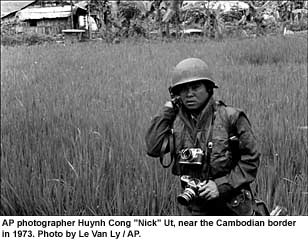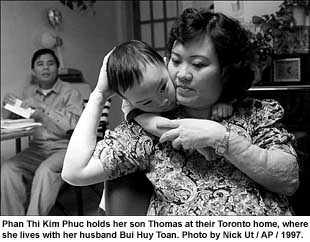|
Nick Ut - Still a
Photographer with the Associated Press
by Horst Faas and Marianne Fulton
 Huynh
Cong Ut was 14 years old when he was introduced to the Associated
Press office in Saigon by his mother. Ut was born on March 29, 1951
in the southern Mekong Delta province of Long An and was the younger
brother of Vietnamese photographer Huynh Thanh My who had been killed
a few weeks earlier while photographing combat action
in the Mekong Delta on October 10, 1965 on assignment for The Associated
Press. Ut was looking for a job and Horst Faas hired him on January
1, 1966, after a trial period of six weeks. It was exactly ten years
after Horst Faas himself had officially joined the AP. Huynh Cong
Ut started in the AP by mixing photo processing chemicals and the
job keeping the photo darkroom tidy. Huynh
Cong Ut was 14 years old when he was introduced to the Associated
Press office in Saigon by his mother. Ut was born on March 29, 1951
in the southern Mekong Delta province of Long An and was the younger
brother of Vietnamese photographer Huynh Thanh My who had been killed
a few weeks earlier while photographing combat action
in the Mekong Delta on October 10, 1965 on assignment for The Associated
Press. Ut was looking for a job and Horst Faas hired him on January
1, 1966, after a trial period of six weeks. It was exactly ten years
after Horst Faas himself had officially joined the AP. Huynh Cong
Ut started in the AP by mixing photo processing chemicals and the
job keeping the photo darkroom tidy.
"I loved the darkroom", Nick Ut remembered
in an interview," I could print the picture by myself and see how
the photographer had taken it. I never took a class in photography,
I learned by seeing the photographers' work and what every day war
looked like."
By 1967 little brother Ut had become
an accomplished news photographer and his photos taken during the
communist Tet offensive testified to his courage and abilities.
Nick recalls: "Horst (Faas) had misgivings. He was afraid I would
get killed, too."
Ut had many close calls. During the
Cambodian campaign he was wounded twice, once in the stomach and
once in the upper right hand chest area. Ironically he was hit a
third time very close to where the picture of Kim had been taken.
North Vietnamese troops had attacked Trang Bang again. "I rushed
towards the area where I knew Kim Phuc was when a mortar exploded
in front of me. I was hit. My colleagues rushed me to the
hospital. I still have some shrapnel in my leg." Nick said.
In his seventh year with The Associated
Press the then 21 year old Huynh Cong Ut , by then called affectionately
'Nick' Ut took one of the most recognized photographs of the
conflict in Vietnam, winning journalism's highest honor, The Pulitzer
Prize for Photography in 1973 for his picture of the then
9-year old girl Phan Thi Kim Phuc running away from the fire of
napalm and screaming in pain.
The photograph also won awards from
World Press Photo, Sigma Delta Chi, the George Polk Memorial award,
an award of the Overseas Press Club and the award of the Associated
Press Managing Editors (APME).
The photograph changed the lives of
both the photographer Huynh Cong Ut and his subject, the "napalm
girl" from Trang Bang, Phan Thi Kim Phuc.
Ut was evacuated on April 22, 1975,
during the last week of the Vietnam War, in a plane headed for the
Philippines. A few days earlier he had tried to get through to Kim
Phuc again - but the roads had already been overrun by the North
Vietnamese Army.
Although only 24 years old he had
covered the war for eight years.
"I went to my house and picked up
some of my camera gear and my sister in law, Arlette (widow of his
late brother Huynh Thanh My) and her then ten-year old daughter
and we got out right away. My mother stayed behind. She cried. I
also left some camera gear and all my personal negatives and pictures,"
said Nick Ut.
He found himself like many other Vietnamese
refugees living in the tent cities of Camp Pendleton Marine Corps
base in Southern California. Within a month, the prize winning photographer
was transferred to AP's Tokyo bureau. Two years later, 1977, he
arrived in Los Angeles where he continues to work as an AP photographer
on general assignment work and where he became an American citizen.
Nick Ut returned to Vietnam for the
first time in 1989 to work on a story about the search for Americans
missing in action (MIA's).
In 1993 he was asked to open The Associated
Press ' new Hanoi bureau with his old friend and Saigon colleague
George Esper. In April 2000 Nick Ut, accompanied by his old bosses
of 1972, Horst Faas (Photos) and Richard Pyle (Chief of Bureau,
Saigon) revisited Trang Bang and met Phan Thi Kim Phuc's relatives
who still live within hundred yards of the scene of the incident
of June 8, 1972.
Ut and his wife, Le Tuyet Hong, live
in Monterey Park, California, with their two children.
Kim Phuc as a Goodwill Ambassador
of the United
Nations and the Publication of
the Story of her Life.
Kim Phuc has become an anti-war symbol
in the West. Vietnam had used her as an anti-American symbol
before her defection in 1992. She has no regrets.
Kim Phuc (her name means "Golden Happiness"
) had spent 14 months recovering from her wounds and underwent 17
transplants and other operations.
In November 1997 Kim Phuc was named
by Director General Frederico Mayor a Goodwill Ambassador of the
United Nations Educational, Scientific and Cultural Organization
(UNESCO) "for a culture of peace". The event took place during
a plenary session of the UNESCO General Conference.
She also established the Kim Foundation
(healing children of war) with offices in Ajax, Ontario, Canada
and Chicago IL, financed by voluntary donations. "I want to
give back in the same way that so many gave to my healing", she
said at the UNESCO ceremony in Paris. "Yes, I forgive, but I don't
forget in order to prevent the same thing from happening again."
Kim Phuc now aspires to learn French
and has signed up for language courses in Montreal.
Her husband Bui Huy Toan occupies
himself with helping people in Canada who have difficulties to communicate.
The visit to London was his first to Europe since his marriage to
Kim Phuc. When both are traveling Kim's parents take care of their
two sons. They joined them in Canada in 1998.
In 1999 the book of Kim Phuc's life,
"The Girl in the Picture: The Story of Kim Phuc, the Photographer
and the Vietnam War" by Denise Chong was published by Viking, in
the Penguin Publishing Group, Canada. Editions in the U.S.A. and
Britain will follow in mid-2000. It is the story of the "napalm
girl" as she struggles to reclaim her life.
Not Yet Ready to Return to Vietnam.
Kim Phuc's family in Canada.
 Kim
Phuc has not visited her homeland since leaving in 1986. "I am not
ready yet, financially or emotionally," she said Tuesday, June 27,
2000. "Some day, I'll go. Now I'm just happy to be free." Kim
Phuc has not visited her homeland since leaving in 1986. "I am not
ready yet, financially or emotionally," she said Tuesday, June 27,
2000. "Some day, I'll go. Now I'm just happy to be free."
Kim Phuc, who was successfully treated
for her burns in West Germany (her medical treatment was arranged
and financially supported by the magazine Der Stern ) later studied
and married a fellow student, Bui Huy Toan in Havana, Cuba.
They both defected to the West in
1992, stepping off during a refueling stop in Gander, Newfoundland,
Canada, during a flight between Moscow to Havana, Cuba.
She now lives with her husband Bui
Huy Toan, her two boys Thomas (6) and Stephen (3) in a small
apartment in Toronto, Canada.
Kim Phuc has become a catholic and
goes to church.
In the late nineties the family was
joined by her parents Mr. Phan The Ngoc (75) and Mrs. Do Ngoc Nu
(69).
|